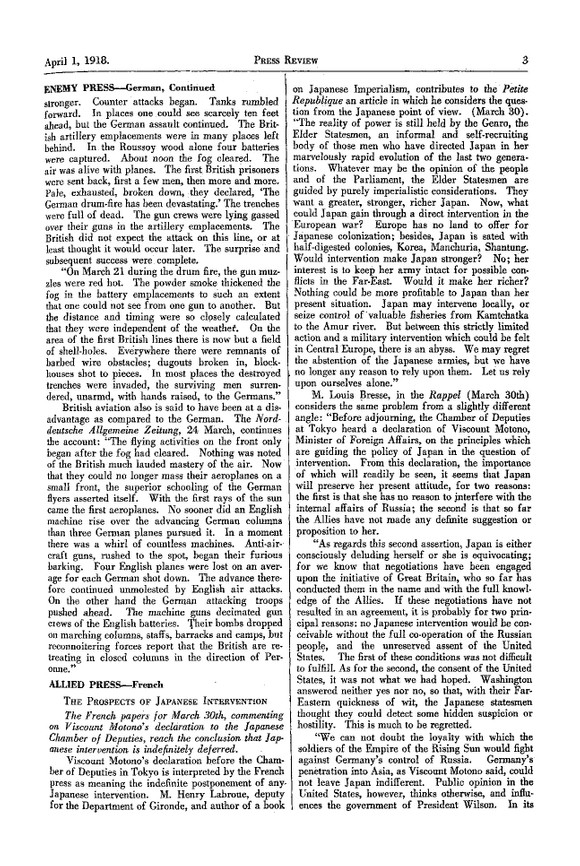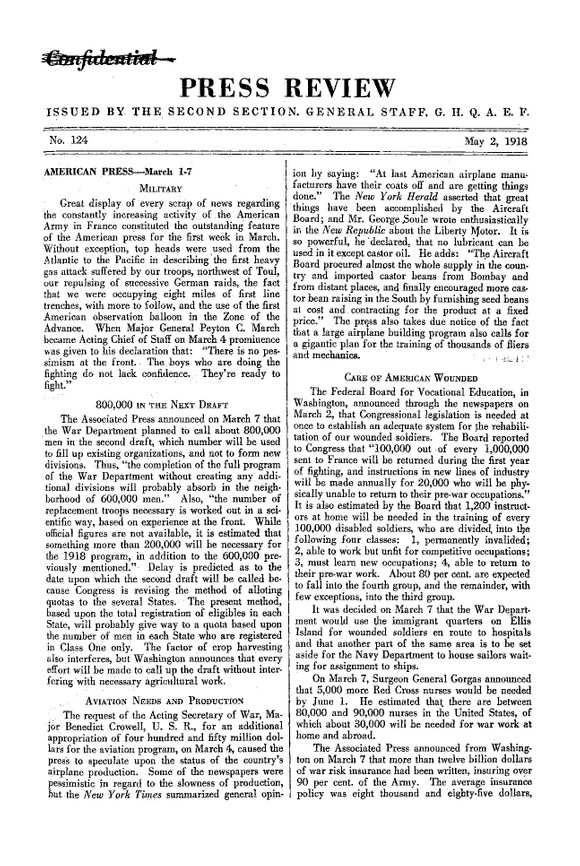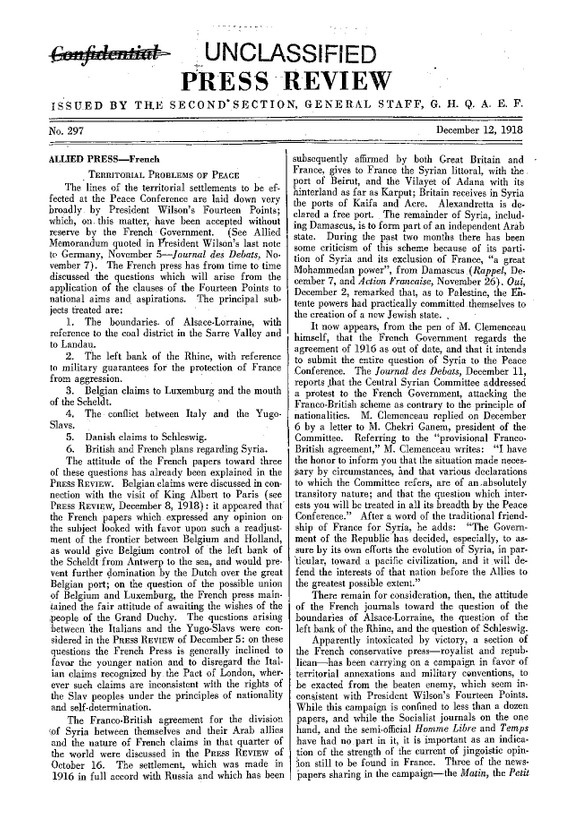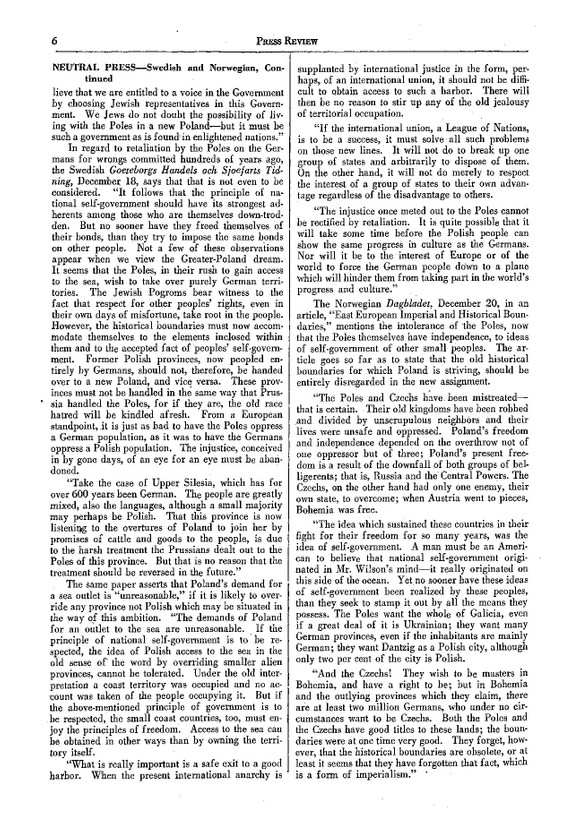Starting from:
$14.95
Home
World War I
World War I Press Review of Allied, Enemy and Neutral Press by the American Expeditionary Force
World War I Press Review of Allied, Enemy and Neutral Press by the American Expeditionary Force
World War I Press Review of the Allied, Enemy and Neutral Press by the General Staff American Expeditionary Force.
2,588 pages of Press Review issued by the second section, General Staff American Expeditionary Force, distributed only to the General Headquarters Staff. The complete run of this bulletin, December 12, 1917 to September 30, 1918. The Press Review was intended to fill a need for a means of following the trend of opinion on vital questions affecting the war as reflected by the press comments that appeared in the newspapers of the enemy, the allies, and neutral countries.
The Press Review was a printed document of about 4,000 words, containing articles summarizing and explaining the current journalistic opinion of particular nations, Allied, enemy and neutral, with reference to important issues or events, necessary for the proper estimation of political conditions and developments in the nation or nations concerned.
The Press Review was first published December 12, 1917, and was continued until August 16, 1918, when it was suspended until September 27, 1918, for the purpose of reorganization and increase of personnel. Since the resumption it was published daily until June 16, 1919. Originally the issues were classified as SECRET, but later the classification of the issues were changed to CONFIDENTIAL. The issues were printed at Base Printing Plant, 29th Engineers, U.S. Army, France.
A corps of translators was constantly employed in making translations
from the press for publication in the daily Press Review. From eight to forty newspapers were received daily from each of the principal European powers and from America. Articles of interest to G-2 were clipped and indexed.
The Press Review aimed to cover the important journalistic opinion of the principal European countries, belligerent and neutral. The American press was also included, although the delay in the receipt of the necessary
papers and the fact that important American press comment was frequently reproduced in the Paris edition of the American and British newspapers made both impossible and unnecessary such close and continuous reviewing as was demanded by the principal presses of Europe.
In addition to America the nations whose journals were covered by the Press Review were the following: Allied--France, Great Britain and Italy: Enemy--Germany, Austria and Hungary: Neutral--Denmark, Holland, Norway, Spain, Sweden, Belgium and Switzerland. Copies of all the important daily, weekly and monthly newspapers and periodicals representing all important shades of opinion in these countries were reviewed by the contributors to the Press Review.
Each issue of the Press Review generally contained three or four articles each of which was a resume complete in of itself of press opinion. Verified by quotation and explained by a brief elucidation of the facts of the issues involved.
A careful consideration of press comments and the knowledge of the political leanings of the papers and their sources of information frequently gave an excellent guide to official opinion in the country in which they were published. The Press Review was not a mere patchwork clipped from editorial articles: it was on the contrary a cold-blooded analysis.
The nature and style of the articles in the Press Review and the methods followed in their preparation are best explained by following the instructions given to its contributors:
"It is absolutely necessary that every contribution be reduced to the briefest form compatible with a comprehensive treatment of the subject in hand. In the majority of cases this will be most easily accomplished if the writer commences the article with a general summary of the facts or opinions which are to be set forth. The summary should also explain any differences in attitude which are observable between different groups of papers. It is usually best to group the papers on political lines. When generalizations concerning the attitude of any group of papers are thus given, the names of papers belonging to this group which have been laid under consideration should be stated. Following the summary should come a list of quotations illustrating all the statements made in the Summary. It is obvious that quotations must be made as brief as possible and will represent those papers only which express different points of view or related facts not given elsewhere. In some cases, a concluding paragraph summarizing paints which could not be comprehensible until the quotations themselves had been read, may be added."







2,588 pages of Press Review issued by the second section, General Staff American Expeditionary Force, distributed only to the General Headquarters Staff. The complete run of this bulletin, December 12, 1917 to September 30, 1918. The Press Review was intended to fill a need for a means of following the trend of opinion on vital questions affecting the war as reflected by the press comments that appeared in the newspapers of the enemy, the allies, and neutral countries.
The Press Review was a printed document of about 4,000 words, containing articles summarizing and explaining the current journalistic opinion of particular nations, Allied, enemy and neutral, with reference to important issues or events, necessary for the proper estimation of political conditions and developments in the nation or nations concerned.
The Press Review was first published December 12, 1917, and was continued until August 16, 1918, when it was suspended until September 27, 1918, for the purpose of reorganization and increase of personnel. Since the resumption it was published daily until June 16, 1919. Originally the issues were classified as SECRET, but later the classification of the issues were changed to CONFIDENTIAL. The issues were printed at Base Printing Plant, 29th Engineers, U.S. Army, France.
A corps of translators was constantly employed in making translations
from the press for publication in the daily Press Review. From eight to forty newspapers were received daily from each of the principal European powers and from America. Articles of interest to G-2 were clipped and indexed.
The Press Review aimed to cover the important journalistic opinion of the principal European countries, belligerent and neutral. The American press was also included, although the delay in the receipt of the necessary
papers and the fact that important American press comment was frequently reproduced in the Paris edition of the American and British newspapers made both impossible and unnecessary such close and continuous reviewing as was demanded by the principal presses of Europe.
In addition to America the nations whose journals were covered by the Press Review were the following: Allied--France, Great Britain and Italy: Enemy--Germany, Austria and Hungary: Neutral--Denmark, Holland, Norway, Spain, Sweden, Belgium and Switzerland. Copies of all the important daily, weekly and monthly newspapers and periodicals representing all important shades of opinion in these countries were reviewed by the contributors to the Press Review.
Each issue of the Press Review generally contained three or four articles each of which was a resume complete in of itself of press opinion. Verified by quotation and explained by a brief elucidation of the facts of the issues involved.
A careful consideration of press comments and the knowledge of the political leanings of the papers and their sources of information frequently gave an excellent guide to official opinion in the country in which they were published. The Press Review was not a mere patchwork clipped from editorial articles: it was on the contrary a cold-blooded analysis.
The nature and style of the articles in the Press Review and the methods followed in their preparation are best explained by following the instructions given to its contributors:
"It is absolutely necessary that every contribution be reduced to the briefest form compatible with a comprehensive treatment of the subject in hand. In the majority of cases this will be most easily accomplished if the writer commences the article with a general summary of the facts or opinions which are to be set forth. The summary should also explain any differences in attitude which are observable between different groups of papers. It is usually best to group the papers on political lines. When generalizations concerning the attitude of any group of papers are thus given, the names of papers belonging to this group which have been laid under consideration should be stated. Following the summary should come a list of quotations illustrating all the statements made in the Summary. It is obvious that quotations must be made as brief as possible and will represent those papers only which express different points of view or related facts not given elsewhere. In some cases, a concluding paragraph summarizing paints which could not be comprehensible until the quotations themselves had been read, may be added."







1 file (213.1MB)



